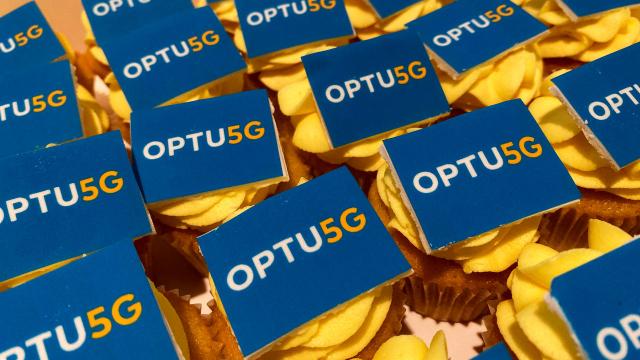Today Optus became the second telco is Australia to launch 5G.
While Optus has been trialling 5G home broadband since earlier in the year and recently began stocking 5G-enabled phones, it’s now official.
But it still can’t guarantee that 5G will work indoors.
[referenced url=”https://gizmodo.com.au/2019/10/optus-5g-australia/” thumb=”https://gizmodo.com.au/wp-content/uploads/2019/08/s10-5g-4-410×231.jpg” title=”Optus Is Releasing 5G Phones But Its 5G Doesn’t Work Indoors” excerpt=”Last week Optus announced it had begun selling plans for two more 5G-enabled phones – the Samsung S10 5G and the Oppo Reno 5G ” which brings its suite of 5G devices to three, including the Samsung Note 10+ 5G which drops in October. On the surface this seems exciting, until you consider its 5G network is far from being completed. Despite these devices being sold to customers, Optus mobile 5G doesn’t even work indoors yet.”]
We covered the state of Optus’ 5G mobile network last month. And despite it being officially launched today, not much has changed.
The network is still unlikely to work indoors, though you might get lucky depending on where you live.
And we can probably expect this level of coverage indoors until Optus’ in-building antennas, which are older, are upgraded to support 5G. This won’t start happening until mid-2020.
As we reported last month, the disclosure regarding indoor coverage is still buried in the coverage map section of the telco’s 5G landing page as well as the terms and conditions of the individual mobile plans.
When questioned about in-building coverage at a press conference earlier today, Optus CEO Allen Lew said, “The indoor antenna technology will take awhile to catch up… so the network today will be on a best efforts basis for indoor. Definitely from the second half of next year onwards we will start to retrofit.”
A great deal of the narrative around Optus’ 5G announcement has been about the future – that it will be capable of live 4K video streaming in mid-2020 and that there will be lower latency in 2021. But what will customers get until then?
According to Lew, the answer is good 4G, as well as 5G-ready devices.
“The most important thing is that depending where they are and the construction of the building they may get 5G indoors. But it will be supplemented by our already fast 4G network. So you may not get 500Mbps but you’ll certainly get more than 300Mbps on 4G,” said Lew.
“Things will change significantly in 2021 because also I do think that the next generation of 5G handsets, as we’ve seen with 4G, will be much more effective and much better… so things will change.”
Lew went on to reiterate the same argument that Optus made last month – that an apparent large percentage of Australians may want to buy a 5G device (even if they can’t access the network or use it consistently) simply to have a device that is future-proofed.
At the moment that includes the Samsung Galaxy Note 10 5G, Samsung Galaxy S10 5G and the Oppo Reno 5G. The cheapest available plan is with the latter device, which we’re big fans of, butit only comes with 4GB data a month – not ideal for a high speed network.
We’d recommend checking out the plans for all three devices carefully to ascertain what would be best for your lifestyle.
[referenced url=”https://gizmodo.com.au/2019/11/optus-5g-cost/” thumb=”https://gizmodo.com.au/wp-content/uploads/2019/11/optus-5G-sign-410×231.jpg” title=”Optus Might Charge Extra For 5G In The Future” excerpt=”Earlier this year Telstra significantly changes its mobile plans, with an emphasis placed on bolt-on services. The narrative around this choice was to not charge customers for services they don’t want. One of these services is access to 5G, which customers on lower tiered plans will need to pay an extra $15 a month for after June 30, 2020. Today Optus officially launched its own 5G offerings, so we were wondering if they too would charge for 5G in the future. They didn’t say no.”]
Optus 5G Home was also launched today, after being trialled since January.
There is still only one plan currently available – $70 a month gets you unlimited data and a Nokia 5G modem. It’s the same price whether you want to go on a 24-month contract or keep it casual on a month-to-month basis. However, if you opt for the latter you’ll also be charged a $200 start-up fee.
Only 200 customers have been using the service during the trial period, but it will now be available to 138,000 homes in select areas.
Optus stated that they won’t sell this plan to customers unless there is a 95 per cent chance of 5G working in their home.
Optus is also still offering its 50Mbps guarantee, allowing customers to cancel a plan at no charge if they don’t get a minimum of 50mbps down on their connection.
It will be interesting to see how 5G across the board improves of the next year, Like 3G and 4G before it, the network will get faster – especially when mmWave spectrum is introduced. Until then, we do question whether networks should be launched when they don’t consistently work in the most convenient places – indoors.
[referenced url=”https://gizmodo.com.au/2019/10/mmwave-5g-australia-26ghz/” thumb=”https://gizmodo.com.au/wp-content/uploads/2018/12/5G-410×231.jpg” title=”Government To Auction Australia’s First mmWave 5G Spectrum” excerpt=”The Australian government has announced its intentions to auction off 2.4GHz of spectrum in the 26GHz band to telcos in early 2021. This will be the first time that Aussies will have access to mmWave spectrum, which is significantly faster than the current 3.6GHz band.”]
